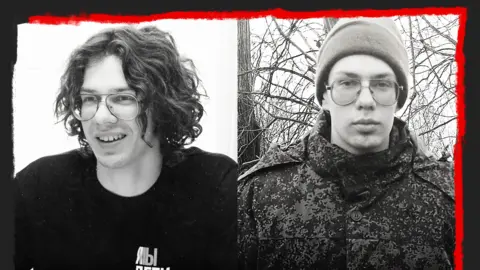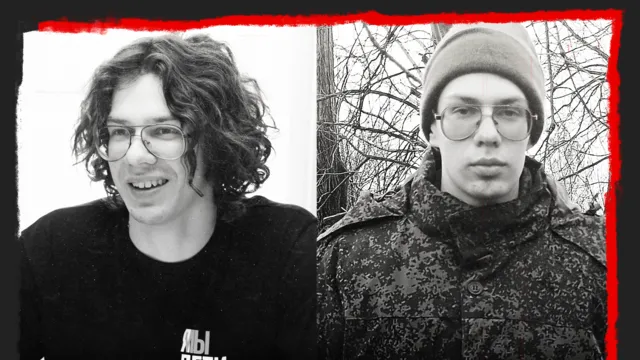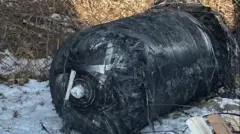BBC News Russian
 BBC
BBCOver 95,000 people fighting for Russia’s military have now died as the war in Ukraine enters the fourth year, according to data analysed by the BBC.
This figure doesn’t include those who were killed serving in the militia of the self-proclaimed Donbas republics which we estimate to be between 21,000 and 23,500 fighters.
BBC Russian, independent media group Mediazona and volunteers have been counting deaths since February 2022.
The list includes names of the deceased that we verified using information from official reports, newspapers, social media, and new memorials and graves. The real death toll is believed to be much higher.
Drafted and disposable
Daniil Dudnikov, a 21-year-old history student at Donetsk National University, was reading international relations and enjoyed swimming.
On the first day of Russia’s full-scale invasion of Ukraine, on 24 February 2022, the authorities in the self-proclaimed Donetsk People’s Republic forcibly mobilised Daniil and despatched him to the Kharkiv region.
Just a month later, on 25 March, Daniil went missing in action. Of the 18 soldiers in his unit, none returned. 13 were killed, and five were taken prisoner. Four months later, following a prisoner exchange, those who had survived confirmed that Daniil had been one of the 13 killed in combat.
Daniil’s story mirrors those of thousands of other residents from the self-declared Donetsk and Luhansk People’s Republics, created in 2014 by Moscow-backed separatists in the predominantly Russian-speaking parts of eastern Ukraine.
With the full-scale Russian invasion in 2022, civilian men were drafted en masse, often inadequately trained and poorly equipped before being assigned to near-impossible missions. This resulted in a staggering number of dead and missing soldiers, the fate of whom often remains unknown for months or years.
According to our analysis of published obituaries and missing persons reports from the regions, the majority of deaths in Donbass militias occurred during the first year of the invasion, a toll comparable to the total number of confirmed Russian military losses over the same period – 25,769 deaths.
Yet despite many people in the occupied parts of eastern Ukraine having relatives or friends in Russia, they are far less integrated into the country’s everyday life, which makes their losses less “visible” to ordinary Russians.
Criminals in combat
Another large part of the Russian losses are convicts recruited in prisons.
Ildus Sadykov was 59 when he was arrested for stealing a bag at a railway station in Moscow. It was the fourth time he ended up in jail, having spent a total of 16 years behind bars for separate criminal convictions.
“They told me, ‘If you don’t want to go back to prison, sign a contract.’ They assured me that at my age, I wouldn’t be sent to the front, just assigned to an auxiliary role. Well, I went along with it.” He recalls, speaking as a prisoner of war after being captured by Ukrainian forces in the summer of 2024.
Following a prisoner exchange, he was returned to Russia, where he was sent back to the frontlines again. This month, Ildus Sadykov was killed in combat.
Currently, the BBC Russian database of war casualties includes 16,171 convicted criminals who were recruited from penal colonies to fight. These are just the cases in which we could verify criminal records through open sources. The actual number of deceased convicts is likely far higher.
By including an analysis of leaked documents from the Wagner Group private military company, we can estimate that prisoners may make up as much as a third of Russia’s military fatalities over the three years of the invasion. Many of these individuals lived in correctional facilities, effectively cut off from broader society, for years on end.
A war few can see
“The losses are felt most by segments of Russian society with fewer resources, be they educational, financial, or political,” says Gulnaz Sharafutdinova, director of the Russia Institute at King’s College London.
“The Kremlin seems to have designed it this way, ensuring that the most privileged sections of society remain largely disconnected from the war. Hence recruitment of prisoners and foreign mercenaries.”
“In small towns, people are far more aware of the scale of casualties. The war has hit social groups that lack the means not only to protest but even to express their views openly. Discussions are confined to private conversations,” she adds.
Only 30% of Russians have had direct exposure to the war, either by fighting in it or family connections to combatants, according to a public opinion poll from the Chronicles project in September 2024. The proportion of Ukrainians who know someone killed or wounded is almost 80%.
Measuring genuine support for the war in Russia is difficult, since many respondents fear speaking honestly. But a study commissioned by the PROPA project, supported by the University of Helsinki, found that 43% of surveyed Russians openly backed the invasion.
“Would public attitudes toward the war be different if more people personally knew the fallen?” asks leading Russian sociologist Viktor Vakhshtayn. “Without a doubt.”
Counting the dead
Russia’s actual losses are almost certainly substantially higher than open-source data can reveal. The military analysts we have consulted estimate that the BBC’s research, which is based on graveyards, war memorials, and obituaries, probably captures only 45% to 65% of total casualties.
Added to which, the bodies of many of those killed in recent months likely remain on the battlefield, since retrieving them requires living soldiers to risk exposure to drone strikes.
Given the estimate above, the true number of Russian military deaths could range from 146,194 to 211,169. If one adds estimated losses from DPR and LPR forces, the total number of Russian-aligned fatalities may range from 167,194 to 234,669.
Russia last officially reported its military losses in September 2022, and cited fewer than 6,000 deaths.
Ukraine last updated its casualty figures in December 2024, when President Volodymyr Zelensky acknowledged 43,000 Ukrainian deaths among soldiers and officers. Western analysts believe this figure to be an under-estimate.
The website Ukraine Losses, which compiles casualty data from open sources, currently lists more than 70,400 surnames of Ukrainian soldiers. Our verification of a random sample of 400 of them found the database to be reliable.
The Ukrainian casualty list is likely more complete than the Russian equivalent, as Ukrainian presidential decrees on posthumous military awards remain publicly accessible. In Russia such data is classified.
As the war approaches its fourth year, global attention has shifted to the new U.S. administration’s push for peace negotiations. We continue to monitor activity at Russian military cemeteries and war memorials, and analyse obituaries, which have surged sharply in number since September last year.




